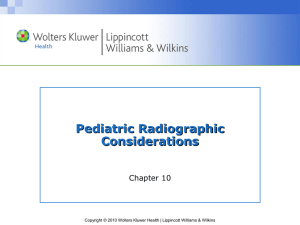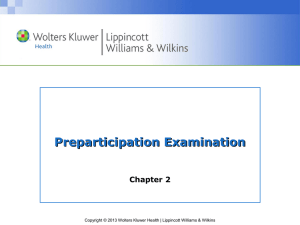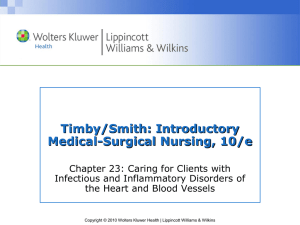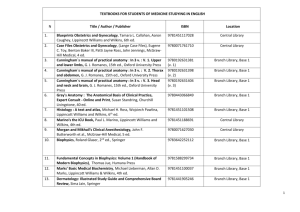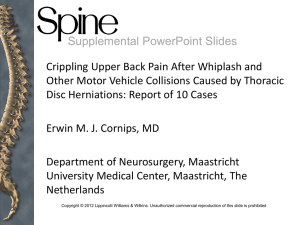Components of Physical Examination (cont'd)
advertisement
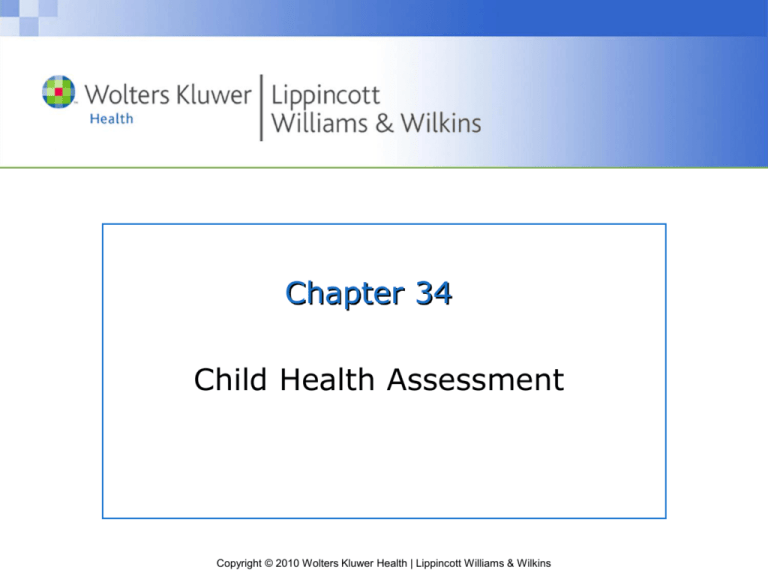
Chapter 34 Child Health Assessment Copyright © 2010 Wolters Kluwer Health | Lippincott Williams & Wilkins Nursing Process: Health Assessment • Assessment • Nursing diagnosis • Outcome identification, planning • Implementation • Outcome evaluation Copyright © 2010 Wolters Kluwer Health | Lippincott Williams & Wilkins Health History: Database • Interview setting • Types of questions – Closed-ended – Open-ended – Compound – Expansive – Leading Copyright © 2010 Wolters Kluwer Health | Lippincott Williams & Wilkins Health History: Database (cont’d) • Health interview – Introduction, explanation – Demographic data – Chief concern – History of chief concern – Health, family profile Copyright © 2010 Wolters Kluwer Health | Lippincott Williams & Wilkins Health History: Database (cont’d) • Health interview – Day history • Play • Sleep • Hygiene • Nutrition Copyright © 2010 Wolters Kluwer Health | Lippincott Williams & Wilkins Health History: Database (cont’d) • Past health history • Family health history • Review of systems Copyright © 2010 Wolters Kluwer Health | Lippincott Williams & Wilkins Physical Assessment • Purpose, techniques • Equipment, setting, approach • Variations – Newborn – Infant – Toddler, preschooler – School age, adolescent Copyright © 2010 Wolters Kluwer Health | Lippincott Williams & Wilkins Components of Physical Examination • Vital signs • General appearance • Mental status Copyright © 2010 Wolters Kluwer Health | Lippincott Williams & Wilkins Components of Physical Examination (cont’d) • Body measurements – Weight – Height – Head circumference – Chest, abdominal circumference – Skin Copyright © 2010 Wolters Kluwer Health | Lippincott Williams & Wilkins Components of Physical Examination (cont’d) • Head – Newborn, infant – Toddler, preschooler, school age – Adolescent Copyright © 2010 Wolters Kluwer Health | Lippincott Williams & Wilkins Components of Physical Examination (cont’d) • Eyes – Conjunctivitis – Hordeolum – Ptosis – Strabismus – Esotropia – Exotropia Copyright © 2010 Wolters Kluwer Health | Lippincott Williams & Wilkins Components of Physical Examination (cont’d) Copyright © 2010 Wolters Kluwer Health | Lippincott Williams & Wilkins Components of Physical Examination (cont’d) • Eyes – Newborn, infant – Toddler, preschooler – School age, adolescent Copyright © 2010 Wolters Kluwer Health | Lippincott Williams & Wilkins Components of Physical Examination (cont’d) • Nose – Newborn, infant – Older children • Ears – Newborn, infant – Older children Copyright © 2010 Wolters Kluwer Health | Lippincott Williams & Wilkins Components of Physical Examination (cont’d) Copyright © 2010 Wolters Kluwer Health | Lippincott Williams & Wilkins Components of Physical Examination (cont’d) • Mouth – Newborn, infant – Older children • Neck – Newborn, infant – Adolescent Copyright © 2010 Wolters Kluwer Health | Lippincott Williams & Wilkins Components of Physical Examination (cont’d) • Chest • Breasts – Newborn – School age, adolescent • Lungs – Newborn, infant Copyright © 2010 Wolters Kluwer Health | Lippincott Williams & Wilkins Components of Physical Examination (cont’d) Copyright © 2010 Wolters Kluwer Health | Lippincott Williams & Wilkins Components of Physical Examination (cont’d) • Heart – PMI – Heart sounds – Rhythm – Newborn, infant, toddler – School age, adolescent Copyright © 2010 Wolters Kluwer Health | Lippincott Williams & Wilkins Components of Physical Examination (cont’d) Copyright © 2010 Wolters Kluwer Health | Lippincott Williams & Wilkins Components of Physical Examination (cont’d) • Abdomen – Newborn, infant – Preschooler, school age • Genitorectal area – Female – Male – Inguinal hernia Copyright © 2010 Wolters Kluwer Health | Lippincott Williams & Wilkins Components of Physical Examination (cont’d) • Extremities • Back • Neurologic function – Motor, sensory Copyright © 2010 Wolters Kluwer Health | Lippincott Williams & Wilkins Components of Physical Examination (cont’d) See Figure 34.21. Copyright © 2010 Wolters Kluwer Health | Lippincott Williams & Wilkins Vision Assessment • Vision screening • Techniques – Snellen chart – Preschool E chart – National Association for the Prevention of Blindness Home Test – Allen cards Copyright © 2010 Wolters Kluwer Health | Lippincott Williams & Wilkins Vision Assessment (cont’d) • Techniques – Stycar cards – Titmus Vision tester – Color vision discrimination testing • Vision referrals Copyright © 2010 Wolters Kluwer Health | Lippincott Williams & Wilkins Hearing Assessment • Auditory screening – Newborn, infant – Older children • Principles of audiometric assessment – Frequency – loudness Copyright © 2010 Wolters Kluwer Health | Lippincott Williams & Wilkins Hearing Assessment (cont’d) • Hearing loss • Acoustic impedance testing • Conduction loss testing Copyright © 2010 Wolters Kluwer Health | Lippincott Williams & Wilkins Speech Assessment • Denver Articulation screening – Administration – Scoring Copyright © 2010 Wolters Kluwer Health | Lippincott Williams & Wilkins Developmental Appraisal • Developmental history • Denver II Developmental screening – Administration – Scoring – Prescreening test Copyright © 2010 Wolters Kluwer Health | Lippincott Williams & Wilkins Intelligence • Goodenough-Harris Drawing test Copyright © 2010 Wolters Kluwer Health | Lippincott Williams & Wilkins Temperament • Child’s innate behavioral characteristics – Activity level – Rhythmicity – Tendency to approach or withdraw – Adaptability Copyright © 2010 Wolters Kluwer Health | Lippincott Williams & Wilkins Immunizations • Types • Available vaccines – Diphtheria, tetanus, pertussis (DTaP) – Polio – Measles, mumps, rubella (MMR) – Hepatitis Copyright © 2010 Wolters Kluwer Health | Lippincott Williams & Wilkins Immunizations (cont’d) • Available vaccines – H. influenzae Type B – Varicella – Pneumococcal pneumonia – Human Papillomavirus – Meningococeal Vaccine Copyright © 2010 Wolters Kluwer Health | Lippincott Williams & Wilkins Immunizations (cont’d) • Available vaccines – Lyme disease – Influenza – Anthrax, smallpox Copyright © 2010 Wolters Kluwer Health | Lippincott Williams & Wilkins Immunizations (cont’d) • Administration • Parental education Copyright © 2010 Wolters Kluwer Health | Lippincott Williams & Wilkins Question • Which physical finding would best suggest that an infant is dehydrated? A. A depressed fontanelle B. A caput succedaneum C. Curved fingerbeds D. A listless appearance Copyright © 2010 Wolters Kluwer Health | Lippincott Williams & Wilkins Answer • A. A depressed fontanelle • Rationale: With dehydration, the fontanelles of infants often appear sunken. Copyright © 2010 Wolters Kluwer Health | Lippincott Williams & Wilkins Question • School-aged children run a high incidence of pediculosis. Of the following, which best suggests pediculosis? A. Dry, brittle hair B. Small white particles on the hair strands C. Patches of hair loss D. Weeping circular areas on the scalp Copyright © 2010 Wolters Kluwer Health | Lippincott Williams & Wilkins Answer • B. Small white particles on the hair strands • Rationale: The eggs of lice are revealed as small white particles on hair strands. Copyright © 2010 Wolters Kluwer Health | Lippincott Williams & Wilkins Question • When assessing a child’s heart, which finding would be considered abnormal? A. Physiologic splitting with inspiration B. Presence of a fourth heart sound C. An observable PMI D. Dullness with percussion Copyright © 2010 Wolters Kluwer Health | Lippincott Williams & Wilkins Answer • B. Presence of a fourth heart sound • Rationale: Many children demonstrate physiologic splitting and an observable point of maximum impulse. A fourth heart sound suggests pathology. Copyright © 2010 Wolters Kluwer Health | Lippincott Williams & Wilkins


